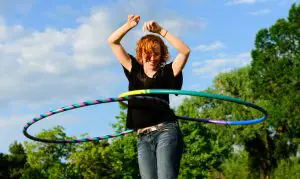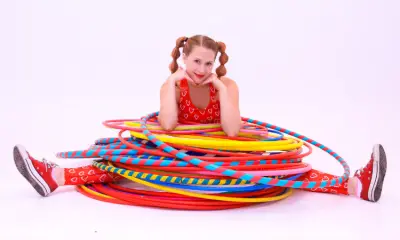When it comes to hula hooping, getting the right size hoop can make all the difference in your spinning success. The perfect hula hoop size isn’t one-size-fits-all; it’s a crucial consideration that varies based on your skill level, body size, and the type of moves you want to master.
Whether you’re a beginner seeking stability or an advanced hooper aiming for intricate tricks, understanding the nuances of hula hoop size is your gateway to a mesmerizing, waist-whirling journey.
What is the standard size for an adult hula hoop?

The standard size for an adult hula hoop can vary, but a common diameter is around 40 to 42 inches (about 102 to 107 cm). However, the ideal size for a hula hoop can depend on factors such as the individual’s height, skill level, and personal preference.
To choose the right size, stand the hula hoop on its edge and make sure it reaches somewhere between your waist and chest when measured against your body.
Some people prefer larger hoops for slower, more controlled movements, while others may prefer smaller hoops for faster and more intricate tricks. It’s essential to find a size that feels comfortable for you and suits your hula hooping style.
Are there different sizes for kids’ hula hoops?
Yes, there are different sizes of hula hoops designed specifically for children. Kids’ hula hoops are typically smaller in diameter compared to adult-sized hoops to better suit the smaller bodies and proportions of children. The size can vary based on the child’s age and height.
Here are some general guidelines for choosing the right size of hula hoop for kids:
- Small Children (ages 2-5): Hoops with a diameter of around 24 to 30 inches (61 to 76 cm) are suitable for younger children who are just starting with hula hooping.
- Elementary School Children (ages 6-12): Hoops with a diameter of approximately 30 to 36 inches (76 to 91 cm) are appropriate for this age group. The size may depend on the child’s height and skill level.
It’s important to consider the individual child’s size, as well as their skill and comfort level when choosing a hula hoop. A hoop that reaches somewhere between the waist and chest level when standing on its edge is a good starting point. As with adult hula hoops, the key is to find a size that allows the child to enjoy the activity and learn the basic techniques comfortably.
How do I choose the right hula hoop size for exercise?
Choosing the right hula hoop size for exercise is crucial for comfort, effectiveness, and enjoyment. Here are some general guidelines to help you select the appropriate size:
- Diameter:
-
- Stand the hula hoop on its edge and ensure it reaches somewhere between your waist and chest.
- For beginners, a larger hoop may be easier to start with as it rotates more slowly, giving you more time to react and learn the movements.
- If you’re more advanced and looking for a challenge, you might prefer a smaller, lighter hoop that requires faster movements.
- Weight:
-
- Consider the weight of the hula hoop. Heavier hoops can provide more resistance and may be suitable for a more intense workout, but they can be more challenging for beginners.
- Lighter hoops are generally easier to use for beginners and can be better for cardiovascular workouts.
- Material:
-
- Hoops are made from various materials, including plastic, PVC, or polyethylene. Plastic hoops are often more rigid, while polyethylene hoops can be softer and more flexible.
- Some hoops are covered in foam or padding, which can make them more comfortable, especially for beginners.
- Skill Level:
-
- Beginners may find larger and heavier hoops more forgiving as they learn the basic movements.
- As you become more skilled, you may want to experiment with smaller and lighter hoops to increase the intensity of your workout.
- Purpose:
-
- Consider your fitness goals. If you’re looking for a low-impact workout and core strengthening, a larger, heavier hoop might be suitable. If you want a more cardiovascular workout, a lighter hoop may be better.
- Trial and Error:
-
- If possible, try out different sizes before making a purchase. Experiment with different diameters and weights to see what feels most comfortable and effective for your fitness routine.
Remember that personal preference plays a significant role, so it’s essential to find a hula hoop size that feels right for you and matches your fitness goals and skill level.
Are there size variations for weighted hula hoops?
Yes, there are size variations for weighted hula hoops, just like with regular hula hoops. The size of a weighted hula hoop can influence the level of difficulty and the type of workout you’ll experience. Weighted hula hoops are designed to add resistance to your exercise routine, helping to engage and strengthen your core muscles.
Here are some considerations for choosing the right size of a weighted hula hoop:
- Diameter:
-
- The diameter of a weighted hula hoop should be chosen based on your height and skill level, similar to regular hula hoops. It should ideally reach somewhere between your waist and chest when placed on its edge.
- Weight:
-
- Weighted hula hoops come in various weights, usually ranging from 1 to 5 pounds or more. The weight can impact the intensity of your workout.
- Beginners may want to start with a lighter weighted hoop and gradually increase the weight as they build strength and endurance.
- More experienced users may opt for a heavier hoop to increase the challenge and intensity of their workout.
- Material:
-
- Weighted hula hoops are often made with materials like plastic or PVC, and they may have added weights distributed throughout the hoop.
- Some weighted hoops have an adjustable weight feature, allowing you to customize the amount of resistance.
When choosing a weighted hula hoop, it’s crucial to consider your fitness level, goals, and personal comfort. Starting with a moderately weighted hoop and adjusting as needed is a good approach.
Additionally, paying attention to the quality and durability of the materials used in the hoop is important for a safe and effective workout. As always, consulting with a fitness professional or healthcare provider before starting a new exercise routine, especially one involving added resistance, is recommended.
Does hula hoop size affect the difficulty of tricks?

Yes, the size of a hula hoop can significantly affect the difficulty of performing tricks. The general rule is that larger hoops rotate more slowly, making them easier to control, while smaller hoops rotate faster, requiring more precision and skill.
Here are some considerations regarding hula hoop size and difficulty:
- Larger Hoops:
- Easier to control: Larger hoops have a slower rotation, which makes them more stable and easier to keep spinning around the body.
- Better for beginners: Beginners often find it easier to learn basic waist hooping and other foundational tricks with a larger hoop.
- Smaller Hoops:
- Faster rotation: Smaller hoops spin faster, making them more challenging to control. This requires greater precision and coordination.
- Suitable for advanced tricks: Smaller hoops are commonly used by more experienced hoopers for advanced tricks, as they allow for quicker movements and intricate manipulations.
- Weight Considerations:
- Heavier hoops: The weight of the hoop can also impact the difficulty of tricks. Heavier hoops may be easier to control but can be more tiring for extended use.
- Lighter hoops: Lighter hoops can be more challenging to control, especially in the beginning, but they allow for quicker and more dynamic movements.
- Personal Preference:
- Individual skill level: Hoopers may have personal preferences based on their skill level and the type of tricks they enjoy performing. Some may prefer the challenge of smaller, faster hoops, while others may find larger hoops more comfortable.
Ultimately, the best hula hoop size for tricks depends on individual skill, preferences, and the specific tricks a hooper wants to master. Beginners might start with a larger hoop and gradually transition to smaller ones as they gain confidence and skill. It’s also common for hoopers to own multiple hoops of different sizes for various styles and tricks.
How does hula hoop size impact waist size?
Using a hula hoop can be a fun and effective way to engage in physical activity and work on your waistline. The size of the hula hoop can impact your experience and effectiveness in different ways:
- Diameter of the Hula Hoop:
-
- Larger Hoops: Bigger hoops rotate more slowly and can be easier for beginners to use. They are generally better for waist hooping, as they provide a larger target area and can be more forgiving if your technique is still developing.
- Smaller Hoops: Smaller hoops rotate more quickly and require more skill to keep them going. They are often used for more advanced hooping techniques and can provide a more intense workout.
- Weight of the Hula Hoop:
-
- Heavier Hoops: A heavier hoop can provide more resistance, making your muscles work harder. This can contribute to a more effective workout and potentially aid in toning the muscles around your waist.
- Lighter Hoops: Lighter hoops are often easier to keep spinning but may not provide as much resistance. They can be good for beginners or for those focusing on coordination and cardiovascular exercise.
- Material of the Hula Hoop:
-
- Weighted Hoops: Some hula hoops are filled with materials like sand or water to add weight. This extra weight can increase the workout intensity, engaging your core muscles more effectively.
- Traditional Plastic Hoops: These are lighter and more commonly used for recreational hooping. They are suitable for beginners and can still provide a good workout, especially when used consistently.
While hula hooping can be a fun way to engage your core muscles and burn calories, it’s essential to note that spot reduction (losing fat in a specific area, like the waist) is not a scientifically supported concept. To reduce waist size, a combination of cardiovascular exercise, a healthy diet, and overall body strength training is generally recommended.
Always consult with a healthcare professional or fitness expert before starting a new exercise routine, especially if you have any existing health concerns or conditions.
Conclusion
Hula hoop size plays a significant role in your hooping experience. Larger hoops are generally more forgiving for beginners and suitable for waist hooping, while smaller hoops provide a more challenging workout. The weight of the hoop also affects the intensity of the exercise, with heavier hoops offering more resistance.
Ultimately, the choice of hula hoop size should align with your skill level, fitness goals, and personal preferences. Remember that consistent exercise, a balanced diet, and overall fitness activities contribute to achieving and maintaining a healthy waist size.


